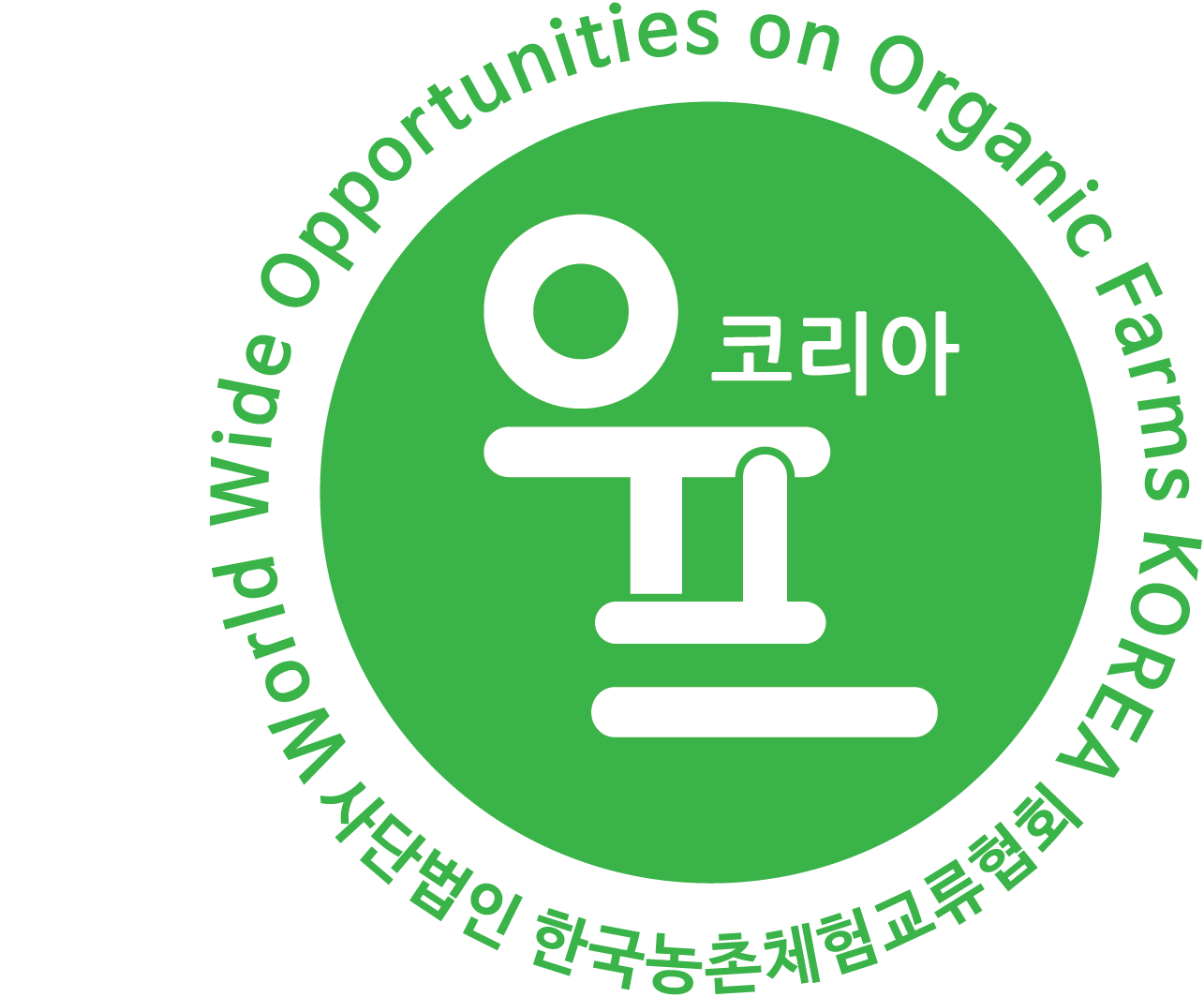A Look into WWOOF Korea with Statistics
A Look into WWOOF Korea with Statistics
As we revamped the WWOOF Korea newsletter, we took the opportunity to analyze statistics about the WWOOFers and hosts who have participated in WWOOF Korea. For WWOOFers, we analyzed gender, age, and nationality based on data from 2023, while for hosts, we looked at region, duration of activity, and age based on current 2024 data.
WWOOFers:
Gender distribution
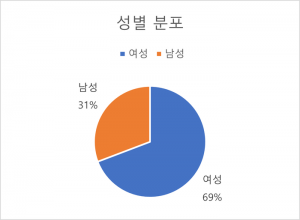 First, let's look at the gender distribution of WWOOFers. The ratio of females is 69%, while males make up 31%. This indicates a significantly higher participation of females, a trend observed not only in Korea but also internationally. When organizing group WWOOF events or observing activities of other organizations, it's evident that males have a lower level of social activity participation compared to females. There could be various reasons for this, but we need to collectively brainstorm ways to encourage more male participation in WWOOFing.
First, let's look at the gender distribution of WWOOFers. The ratio of females is 69%, while males make up 31%. This indicates a significantly higher participation of females, a trend observed not only in Korea but also internationally. When organizing group WWOOF events or observing activities of other organizations, it's evident that males have a lower level of social activity participation compared to females. There could be various reasons for this, but we need to collectively brainstorm ways to encourage more male participation in WWOOFing.
Age distribution
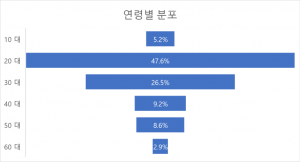 In terms of age distribution, WWOOFers in their 20s and 30s primarily make up over 70% of participants. This statistic is for both Korean (domestic) and foreign (international) WWOOFers. For Koreans, those in their 20s and 30s make up around 60%. There's a gradual increase in 50s and above, with a growing number of inquiries. While those in their 50s and above may feel somewhat hesitant to participate, reaching out to hosts of similar age should make things easier.
In terms of age distribution, WWOOFers in their 20s and 30s primarily make up over 70% of participants. This statistic is for both Korean (domestic) and foreign (international) WWOOFers. For Koreans, those in their 20s and 30s make up around 60%. There's a gradual increase in 50s and above, with a growing number of inquiries. While those in their 50s and above may feel somewhat hesitant to participate, reaching out to hosts of similar age should make things easier.
Country distribution
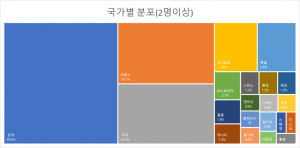 Looking at the distribution by country, WWOOF membership has been registered from approximately 20 countries. The highest number of international WWOOFers comes from France, followed closely by the US with a difference of only 0.3%. Particularly within Europe, France stands out with a high WWOOF participation rate in Korea. Singapore and Germany also show high participation rates. We hope to see WWOOF Korea gain more recognition in more countries
Looking at the distribution by country, WWOOF membership has been registered from approximately 20 countries. The highest number of international WWOOFers comes from France, followed closely by the US with a difference of only 0.3%. Particularly within Europe, France stands out with a high WWOOF participation rate in Korea. Singapore and Germany also show high participation rates. We hope to see WWOOF Korea gain more recognition in more countries
Analyzing the statistics, gender distribution, age distribution, and country distribution have remained relatively consistent from year to year. Female participation remains about twice as high as male participation, and WWOOFers in their 20s continue to be the majority. The ratio of Korean to international participants also remains relatively stable at 4:6.
After the COVID-19 pandemic, the number of WWOOFers is in recovery. We look forward to more countries and more diverse age groups joining WWOOF activity.
Hosts:
Host numbers by their age
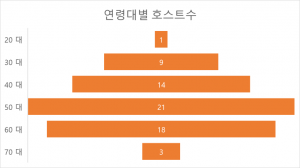 Analyzing hosts by age revealed that those in their 50s make up the highest proportion. Following closely are hosts in their 60s, with even some in their 70s. There is also one in 20s. The presence of hosts in their 20s and 30s, totaling ten individuals, is very encouraging and holds great promise for the future development of Korean agriculture.
Analyzing hosts by age revealed that those in their 50s make up the highest proportion. Following closely are hosts in their 60s, with even some in their 70s. There is also one in 20s. The presence of hosts in their 20s and 30s, totaling ten individuals, is very encouraging and holds great promise for the future development of Korean agriculture.
Host numbers by region
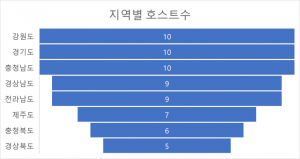 Looking at the distribution by region, Gangwon-do, Gyeonggi-do, and Chungcheongnam-do each have the highest number of hosts, with ten locations each. While the distribution is relatively balanced nationwide, it's regrettable that there are still no hosts in Jeollabuk-do. If there are any excellent farmers in Jeollabuk-do or if any Jeollabuk-do farmers happen to read this, we would be happy if you join WWOOF Korea.
Looking at the distribution by region, Gangwon-do, Gyeonggi-do, and Chungcheongnam-do each have the highest number of hosts, with ten locations each. While the distribution is relatively balanced nationwide, it's regrettable that there are still no hosts in Jeollabuk-do. If there are any excellent farmers in Jeollabuk-do or if any Jeollabuk-do farmers happen to read this, we would be happy if you join WWOOF Korea.
Years of host activity
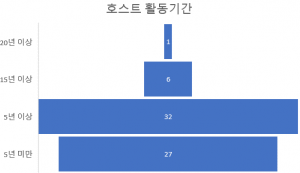 Analyzing the activity duration of hosts, we found that there is one host who has been active for over 20 years, and six hosts who have been active for over 15 years. We extend our gratitude to these hosts who have dedicated their time and effort to being WWOOF hosts for such extended periods. During the last general meeting, we presented tokens of appreciation to hosts who have been active for over 10 years, totaling 17 hosts. Most WWOOF hosts have been active for over 5 years, with a total of 27 hosts, including 17 new hosts from 2024. We are excited about the prospect of new host farms who bring in more excitement.
Analyzing the activity duration of hosts, we found that there is one host who has been active for over 20 years, and six hosts who have been active for over 15 years. We extend our gratitude to these hosts who have dedicated their time and effort to being WWOOF hosts for such extended periods. During the last general meeting, we presented tokens of appreciation to hosts who have been active for over 10 years, totaling 17 hosts. Most WWOOF hosts have been active for over 5 years, with a total of 27 hosts, including 17 new hosts from 2024. We are excited about the prospect of new host farms who bring in more excitement.
These statistics provide valuable insights into the current state of WWOOF Korea, highlighting areas of strength and potential areas for improvement. By continuing to analyze and adapt based on these insights, we can further enhance the WWOOF experience for both WWOOFers and hosts alike.
Analyzing WWOOFers and hosts, it seems that WWOOF Korea is gradually growing. We hope to see both the number of WWOOFers and hosts increase, and we aspire to see natural farming methods implemented in rural areas across Korea. We hope that WWOOF Korea can contribute to the development of rural areas, promote urban-rural exchanges, and ultimately create a society where both urban and rural residents can enjoy a higher quality of life.


